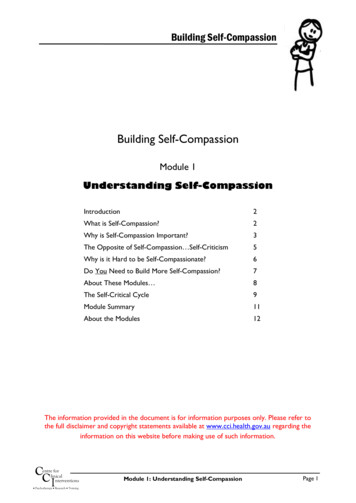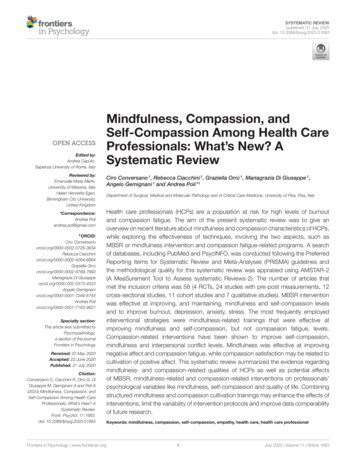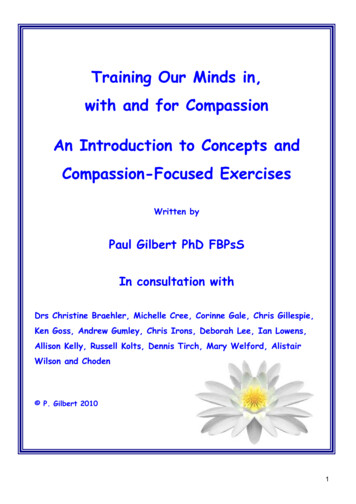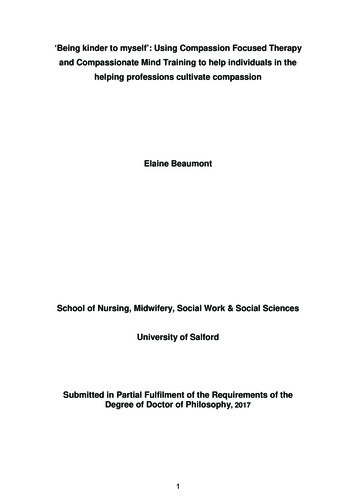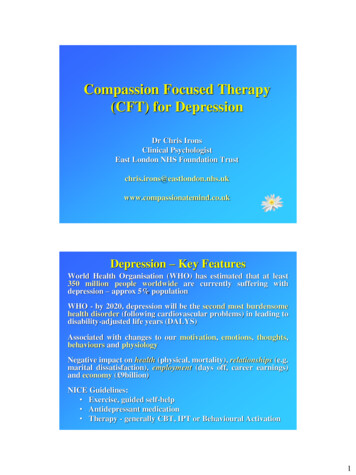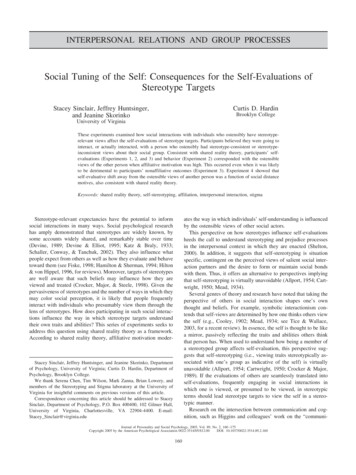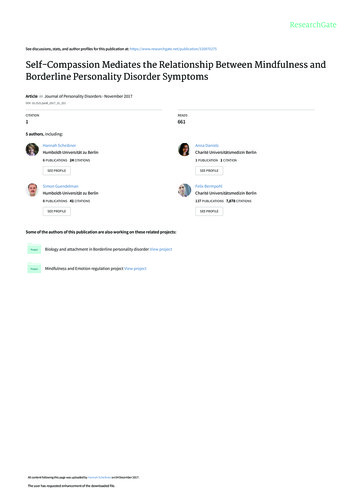
Transcription
See discussions, stats, and author profiles for this publication at: Self-Compassion Mediates the Relationship Between Mindfulness andBorderline Personality Disorder SymptomsArticle in Journal of Personality Disorders · November 2017DOI: 10.1521/pedi 2017 31 331CITATIONREADS16615 authors, including:Hannah ScheibnerAnna DanielsHumboldt-Universität zu BerlinCharité Universitätsmedizin Berlin6 PUBLICATIONS 24 CITATIONS1 PUBLICATION 1 CITATIONSEE PROFILESEE PROFILESimon GuendelmanFelix BermpohlHumboldt-Universität zu BerlinCharité Universitätsmedizin Berlin8 PUBLICATIONS 41 CITATIONS137 PUBLICATIONS 7,878 CITATIONSSEE PROFILESome of the authors of this publication are also working on these related projects:Biology and attachment in Borderline personality disorder View projectMindfulness and Emotion regulation project View projectAll content following this page was uploaded by Hannah Scheibner on 04 December 2017.The user has requested enhancement of the downloaded file.SEE PROFILE
Journal of Personality Disorders, Volume 31, 1-19, 2017 2017 The Guilford PressSELF COMPASSION, MINDFULNESS, AND BPDSCHEIBNER ET AL.SELF-COMPASSION MEDIATES THERELATIONSHIP BETWEEN MINDFULNESSAND BORDERLINE PERSONALITY DISORDERSYMPTOMSHannah J. Scheibner, PhD, Anna Daniels, BSc,Simon Guendelman, MD, Franca Utz, BSc, and Felix Bermpohl, MDIndividuals suffering from borderline personality disorder (BPD) experiencedifficulties with mindfulness. How mindfulness influences BPD symptoms,however, is still unknown. We hypothesized that the relationship betweenmindfulness and BPD symptoms would be mediated by self-compassion.In study 1, we recruited 29 individuals with BPD and 30 group-matchedhealthy controls. In study 2, we complemented our results with findingsfrom a larger, nonclinical sample of 89 participants that were recruited during an open-house event at the local university. All participants completedquestionnaires assessing self-compassion, mindfulness, BPD symptom severity, and emotion dysregulation. In both studies, self-compassion mediatedthe relationship between mindfulness and BPD symptom severity as well asbetween mindfulness and emotion dysregulation. Self-compassion seems tobe one psychological process that could explain the relationship betweenmindfulness and BPD symptoms. One promising approach in therapy couldbe to target self-compassion more directly during mindfulness trainings andinterventions.Borderline personality disorder (BPD) is a complex, severe mental illnesscharacterized by pervasive patterns of instability in emotion regulation,impulse control, interpersonal relationships, and self-image (Leichsenring,Leibing, Kruse, New, & Leweke, 2011; Lieb, Zanarini, Schmahl, Linehan, &Bohus, 2004; Skodol et al., 2002). Recent studies showed that BPD symptomseverity was associated with self-reported difficulties in mindfulness (Baer,Smith, & Allen, 2004; Scheibner, Spengler, Kanske, Roepke, & Bermpohl,2016; Wupperman, Neumann, & Axelrod, 2008). Mindfulness is a conceptderived from Buddhist tradition and has been defined in modern Westernpsychology as nonjudgmental attention to and awareness of the presentmoment (Kabat-Zinn, 1994). Mindfulness stands in contrast to several keyFrom Berlin School of Mind and Brain, Humboldt-Universität zu Berlin, Germany (H. J. S., S. G.); Department of Education and Psychology, Freie Universität Berlin, Germany (A. D.); Department of Psychology, Humboldt-Universität zu Berlin, Germany (F. U.); Charité – Universitätsmedizin Berlin, corporate member of Freie Universität Berlin, Humboldt-Universität zu Berlin, and Berlin Institute of Health,Department of Psychiatry and Psychotherapy, Germany (F. B.).Address correspondence to Hannah J. Scheibner, Berlin School of Mind and Brain, Humboldt-Universitätzu Berlin, Luisenstraße 56, 10115 Berlin, Germany. E-mail: hannahscheibner@posteo.de1
2SCHEIBNER ET AL.symptoms of individuals with BPD, for example, their difficulty to pay attention to and be aware of their own feelings and emotions (Bijttebier &Vertommen, 1999; Leible & Snell, 2004; Levine, Marziali, & Hood, 1997;Yen, Zlotnik, & Costello, 2002). Consequently, mindfulness exercises are acentral mean in the treatment of BPD (Miller, Wyman, Huppert, Glassman,& Rathus, 2000; Stepp, Epler, Jahng, & Trull, 2008), especially in Dialectical Behavioral Therapy (DBT; Linehan, 1993). Some first evidence suggeststhat mindfulness exercises improve BPD symptoms, in particular emotionregulation (Perroud, Nicastro, Jermann, & Huguelet, 2012; Sauer & Baer,2012). However, the psychological processes through which mindfulness isassociated with reduced BPD symptoms are still largely unknown. Here, weargue that the relationship between mindfulness and BPD symptoms is mediated by self-compassion.Self-compassion is defined as an attitude of kindness toward oneself inface of crisis, that acknowledges one’s own emotions without overly identifying with them and sees imperfection as part of being human (Neff, 2003a).Self-compassion consistently displayed positive relationships with psychological well-being and negative relationships with psychopathology in pastresearch (MacBeth & Gumley, 2012; Zessin, Dickhäuser, & Garbade, 2015).In Buddhist tradition, mindfulness has beneficial effects only if it improvessome form of acceptance and compassion (Gilpin, 2008; Rosch, 2007; Salzberg, 2003). Similarly, in Western psychology, self-compassion has beenconceptualized as an outcome of mindfulness practice (e.g., Bishop et al.,2004; Brown, Ryan, & Creswell, 2007). A state of mindful awareness whensuffering allows oneself to acknowledge one’s pain in the first place without judgment. Then, feelings of self-kindness and common humanity canarise to actively soothe the self (Neff & Dahm, 2015). These views are supported by studies showing that increases in mindfulness predict increases inself-compassion (Birnie, Speca, & Carlson, 2010; Shapiro, Brown, & Biegel,2007). Further, in a longitudinal study with non-clinical samples, mindfulness precipitated self-compassion, but not vice versa (Bergen-Cico & Cheon,2014). Moreover, a growing number of studies on the effects of mindfulnessbased training programs demonstrated increases in self-compassion (BergenCico & Cheon, 2014; Birnie et al., 2010; Rimes & Wingrove, 2012; Robins,Keng, Ekblad, & Brantley, 2012; Shapiro, Astin, Bishop, & Cordova, 2005).Further studies showed that mindfulness-induced changes in self-compassion mediated decreases in stress (Shapiro et al., 2007), depressive symptoms(Kuyken et al., 2010), worry, and fear of emotion (Keng, Smoski, Robins,Ekblad, & Brantley, 2012), as well as increases in well-being (Baer, Lykins,& Peters, 2012). In their review on mechanisms of mindfulness meditation,Hölzel et al. (2011) argue that self-compassion works as an emotion regulation strategy, as it teaches how to cope in instances of pain and suffering.At the same time, individuals with BPD commonly experience severe selfcriticism and difficulties in emotion regulation, contrary to mindful and selfcompassionate attitudes, that likely lead to anger and self-harm (Krawitz,2012; Linehan, 1993; Warren, 2015). In sum, self-compassion has been proposed to mediate the relationship between mindfulness and well-being, andseems to target symptoms central to BPD.
SELF COMPASSION, MINDFULNESS, AND BPD3To the best of our knowledge, no study to date has examined the role ofself-compassion in the relationship between mindfulness and BPD symptomsin samples of individuals with BPD as well as healthy controls. Preliminaryevidence stems from a study by Perroud et al. (2012) that assessed BPD patients’ mindfulness skills during and after DBT therapy. Patients only significantly improved on one of four discrete mindfulness dimensions: acceptancewithout judgment. Acceptance without judgment in turn predicted treatmentsuccess. These results suggest that a kind, accepting attitude—similar to selfcompassion—had a major impact on the treatment success of BPD. Furtherpreliminary support of an inverse relationship between BPD and self-compassion stems from a study which investigated mindfulness, self-compassion,and BPD in a nonclinical sample (Rivera, 2013). Not only were self-compassion deficits related to increased BPD symptoms, but self-compassion alsofully accounted for the relationship between mindfulness and BPD symptomcharacteristics. However, as the researchers in the above-mentioned studies either did not assess self-compassion directly (Perroud et al., 2012) ordid not compare its effects between clinical and nonclinical samples (Rivera,2013), further evidence is needed.We here argue that self-compassion explains the relationship betweenmindfulness and BPD, because self-compassion is a result of mindfulnesstraining and helps individuals with BPD to build a kind attitude towardstheir emotions and towards themselves. We tested a model in which mindfulness predicts BPD symptoms, and this relationship is mediated through selfcompassion. This model was based on previous literature that demonstratedbeneficial effects of mindfulness on BPD symptoms (Perroud et al., 2012;Sauer & Baer, 2012), and the mediating role of self-compassion in mindfulness training (Baer et al., 2012; Keng et al., 2012; Kuyken et al., 2010;Shapiro et al., 2007). Since our study was cross-sectional, we cannot drawconclusions about the directionality of the relationship between mindfulnessand BPD, and BPD symptoms could equally predict mindfulness, mediatedthrough self-compassion. In study 1 we collected data from a BPD patientgroup and a healthy control group. In study 2 we aimed to complement ourresults with findings from a larger, more heterogeneous sample of participants from the general population. Based on previous research with thesevariables in patients with BPD (Feliu-Soler et al., 2017) or healthy controls(Rivera, 2013), we included a sample of healthy participants to investigatewhether the relationship between self-compassion, mindfulness, and emotion regulation holds true at different (i.e., healthy, subclinical, and clinical) levels of emotional distress. For this purpose, we operationalized BPDas a continuous measure (Widiger, 1992). General severity of present BPDsymptoms as measured by the Borderline Symptom List (BSL-23; Bohus etal., 2009) and current levels of emotion dysregulation as measured by theDifficulties in Emotion Regulation Scale (DERS; Gratz & Roemer, 2004)were assessed as indicators of BPD symptoms. We also chose emotion dysregulation as an indicator of BPD in line with Linehan’s biosocial theory ofBPD, which postulates emotion dysregulation to be the core symptom of thisdisorder (Linehan, 1993; Linehan, Bohus, & Lynch, 2007).The hypotheses were as follows:
4SCHEIBNER ET AL.Hypothesis 1: In individuals with BPD and a healthy control group, selfcompassion mediates the effect of mindfulness on BPD symptom severity(model 1) and emotion dysregulation (model 2).Hypothesis 2: In a representative sample from the general population,self-compassion mediates the effect of mindfulness on BPD symptom severity(model 1) and emotion dysregulation (model 2).STUDY 1: SELF-COMPASSION AS A MEDIATOR IN INDIVIDUALSWITH BPD AND HEALTHY CONTROLSMETHODStudy 1 was embedded in a larger behavioral study (Scheibner et al., 2016)that aimed at identifying mindfulness deficits in BPD using a behavioral task.The study design was reviewed by the local ethical committee and the investigation was carried out in accordance with the latest version of the declaration of Helsinki. Informed consent of the participants was obtained prior toparticipation and after the nature of the procedures had been fully explained.ParticipantsTwenty-nine individuals with BPD and 30 healthy controls participated inthe current study. Group membership was established using the StructuredClinical Interview for DSM-IV Axis II Personality Disorders (First, Gibbon, Spitzer, Williams, & Benjamin, 1997; Wittchen, Zaudig, & Fydrich,1997) module for BPD. Participants were screened for comorbidity using theStructured Clinical Interview for DSM-IV Axis I and II (First, Gibon et al.,1997; First, Spitzer, Gibbon, & Williams, 1997; Wittchen et al., 1997) andthe Mini-International Neuropsychiatric Interview (Ackenheil, Stotz, DietzBauer, & Vossen, 1999; Sheehan & Lecrubier, 1998). Three trained clinicalpsychologists administered all clinical interviews. To ensure reliability of thediagnosis, two psychologists were present during the diagnostic interviewand afterwards compared their diagnosis.Participants in the group of individuals with BPD had to meet five ormore criteria for BPD. To prevent confounding effects of psychiatric comorbidity, psychotic symptoms and diagnosis of bipolar disorder were exclusioncriteria. Further exclusion criteria for this group were current high suicidaltendency, organic brain damage, and very low intellectual ability (IQ 70).One BPD patient was excluded from the data analysis because the patientdid not adhere to the instructions given in the questionnaires (n 1). Theremaining 28 individuals with BPD (23 females, 82.1%) ranged in age from23 to 59 years with a mean age of 35.82 years (SD 9.65). The majority ofindividuals with BPD (53.6%) had acquired a general certificate of secondary education (German Abitur). Ten participants with BPD reported thatthey were taking antidepressant medication (n 4 SSRI, n 2 SSNRI, and n 4 not specified), one quetiapine, and one pregabalin. One participant occasionally used promethazine and two hypnotic medications; those on-demandmedications were not taken during the last 24 hours prior to testing.
SELF COMPASSION, MINDFULNESS, AND BPD5TABLE 1. Sample Characteristics (Study 1 and Study 2)BPD (n 28) Sex: female (% [n])aAge (years): M (SD)aHC 1 (n 30) HC 2 (n 86)82.1 (23)73.3 (22)40.7 (35) 35.82 (9.65)34.43 (12.08)32.71 (12.58)7.1 (2) 3.3 (1) 1.2 (1) Education (German, % [n])aHauptschulabschlussMittlere Reife20.9 (18) 53.6 (15) 53.3 (16) 75.6 (65) 7.00 (4.00) 0.00 (3.00) 10.7 (3)Abitur Self-compassion: M (SD)11.34 (3.80) ReliabilityMindfulness: M (SD)ReliabilityBPD symptom severity: Mdn (R)bReliability13.3 (4)30.0 (9) Number of BPD criteria: Mdn (R)Reliability1.2 (1) 28.6 (8)FachhochschulreifeEmotion dysregulation: M (SD) NA 20.87 (3.48) 19.03 (4.47) .91.90.931.73 (0.39) 2.76 (0.42) 2.67 (0.43) .77.82.79 2.02 (2.87) 0.11 (0.65) 0.43 (3.00) .91.65.883.64 (0.59) 2.11 (0.51) 2.33 (0.65) .91.90.94Note. BPD group of individuals with BPD; HC 1 group of healthy controls in study 1; HC 2 group of healthycontrols in study 2; M mean; SD standard deviation; Mdn median; R range; NA not applicable as variablewas not measured in respective group. Reliability values correspond to Cronbach’s α. aGroup differences were testedtwo-sidedly; bMedians and the corresponding ranges are reported because data were not normally distributed forthe BSL-23 in both groups of healthy controls, and thus these parameters are representative for the data distribution(Field, 2009). Significant group differences between BPD and HC 1. Significant group differences between BPD andHC 2. Significant group differences between HC 1 and HC 2.Participants in the group of healthy controls had no current mental orpersonality disorder and no history of depression or post-traumatic stressdisorder. This group consisted of 30 participants who were recruited by online advertisement and group-matched for sex (22 females, 73.3%), age (M 34.43, SD 12.08), and highest level of scholarly education (53.3% of thehealthy controls had Abitur) with the respective characteristics of the individuals with BPD. Individuals with BPD and healthy controls did not differsignificantly on sex ratio, age, or education level (see Table 1). Participantsin both groups reported little to no previous history with mindfulness training or meditation, and individuals with BPD reported little to no experiencewith DBT.MeasuresSelf-compassion was measured using the widely employed 26-item Self Compassion Scale (SCS; Neff, 2003b) in its German version (Hupfeld & Ruffieux, 2011). The SCS consists of three bipolar subscales. These representNeff’s (2003a, 2003b) postulated three components of self-compassion: selfkindness (e.g., I’m tolerant of my own flaws and inadequacies) versus selfjudgment (e.g., When times are really difficult, I tend to be tough on myself),common humanity (e.g., I try to see my failings as part of the human condition) versus isolation (e.g., When I’m feeling down I tend to feel like mostother people are probably happier than I am), and mindfulness (e.g., When I
6SCHEIBNER ET AL.fail at something important to me I try to keep things in perspective) versusover-identification (e.g., When something upsets me I get carried away withmy feelings). Respondents self-report their behaviors on a five-point Likertscale from 1 (almost never) to 5 (almost always).Please note that the definition of mindfulness used in the SCS differsfrom the conceptualization of mindfulness by Kabat-Zinn (1994), which isadopted in the present study. Mindfulness in the sense of self-compassionspecifically refers to maintaining perspective in challenging circumstances inorder to soothe the self (Neff & Dahm, 2015).Mindfulness was assessed using the 14-item short form of the FreiburgerFragebogen zur Achtsamkeit (Freiburg mindfulness inventory) in its Germanversion (FFA; Buchheld, Grossmann, & Walach, 2001; Walach et al., 2004).Participants self-rate their subjective experience of mindfulness in everydaylife (e.g., When I notice an absence of mind, I gently return to the experienceof the here and now) on a four-point Likert scale from 1 (rarely) to 4 (almostalways). The short version was shown to be a robust and valid instrument ingeneral and clinical populations. The administration of the short version ofthe FFA is suitable in samples without any knowledge of Buddhist psychology (Walach et al., 2004).In order to assess BPD-typical symptoms, the short form of the Borderline Symptom List was utilized in its German version (BSL-23; Bohus et al.,2009). The BSL-23 consists of 23 items (e.g., I wanted to punish myself orMy mood rapidly cycled in terms of anxiety, anger and depression). Participants self-rate how much they suffered from each problem in the course ofthe previous week on a five-point Likert scale from 0 (not at all ) to 4 (verystrong).Emotion dysregulation was operationalized through the 36-item Difficulties in Emotion Regulation Scale (DERS; Gratz & Roemer, 2004) inits German translation (Ehring, Tuschen-Caffier, Griepenstroh, & Berking,2010). The DERS assesses individuals’ typical levels of emotion dysregulation. Sample items include: “When I’m upset, I feel guilty for feeling thatway” or “I know exactly how I am feeling.” Items are self-rated on a fivepoint Likert scale from 1 (almost never) to 5 (almost always).ProcedureAfter successful recruitment, a questionnaire packet (containing the SCS andthe DERS) was sent to the participants’ homes in order to reduce assessmenttime. Participants were instructed to fill out the questionnaire by themselvesand in a non-distracting environment. The remaining measures (i.e., the FFAand the BSL-23) were completed on the day of the study. Participants werecontinuously encouraged to ask questions if anything was not clear. At studycompletion, participants received monetary reimbursement for their effort.Statistical AnalysesAll analyses were conducted using SPSS statistics 21.0 software package forWindows and all hypotheses were tested at a one-sided significance level
SELF COMPASSION, MINDFULNESS, AND BPD7TABLE 2. Inter-correlations for Main Variables in Each Group (Study 1 and Study 2)BPD (n 28)1 SCS2 FFAHC 1 (n 30)HC 2 (n 86)234234234.72** .56** .49**.55** .47**a .60**.69** .57**a .76** .50** .37* .32*a .44** .54**a .72**3 BSL-23.34*.33*.72**a4 DERS111aNote. SCS Self-Compassion Scale; FFA Freiburger Frageborgen zur Achtsamkeit (Freiburg mindfulness inventory);BSL-23 Borderline Symptom List 23; DERS Difficulties in Emotion Regulation Scale. BPD group of individualswith BPD; HC 1 group of healthy controls in study 1; HC 2 group of healthy controls in study 2. The significancewas tested one-sidedly. aSpearman’s rs is reported as data were not normally distributed for the BSL-23 in both groupsof healthy controls and thus assumptions of Pearson’s r were violated (Field, 2009). *p .05. **p .01.of α .05, unless otherwise specified. Mediation analyses were performedusing bootstrapping methods in the PROCESS SPSS macro (Hayes, 2013).This macro represents the state of the art in mediation analysis, which is toformally test the significance of the indirect effect of the independent variableon the dependent variable by the mediating variable (Hayes, 2009; Zhao,Lynch, & Chen, 2010). For the analysis at hand, non-parametric bootstrapping with bias-corrected bootstrap 95% confidence intervals based on 5,000bootstrap samples was utilized. If zero was not contained within the boundsof the confidence interval, there existed an indirect effect unequal zero in thepopulation with a probability of 95%. This category of mediation analysismakes no assumptions about the sampling distribution of the indirect effect and is appropriate for small samples (Hayes, 2009; Preacher & Hayes,2004).In order to examine the hypothesized interplay between mindfulness,BPD symptoms, and self-compassion, mindfulness was entered as the independent variable, the respective indicators of BPD symptoms as the dependent variables, and self-compassion as the mediating variable (see Figure 1).In other words, this model tested the hypothesis that the association betweenmindfulness and BPD was mediated by self-compassion. Effect size was estimated with k̂2, which is the ratio of the obtained indirect effect to the maximum possible indirect effect given the present study design and data. Thiseffect size was chosen, as it is standardized and bounded, facilitating interpretation. Further, it is insensitive to sample size and allows for the construction of bootstrap confidence intervals (Preacher & Kelley, 2011).RESULTSZero-order correlations for the variables used in the main analyses in bothgroups are shown in Table 2. Results of all conducted mediation analysesare summarized in Tables 3 and 4. As correlations were high between theSCS and the FFA in both groups, multicollinearity measures, namely, thetolerance factor (TOL) and the variance inflation factor (VIF) were checked(BPD: TOL 0.49, VIF 2.05; HC 1: TOL 0.70, VIF 1.43) and did notexceed critical values (TOL 0.1, VIF 10; Eid, Gollwitzer, & Schmitt,2013; Field, 2009).
8SCHEIBNER ET AL.FIGURE 1. Simple mediation analyses where the effect of mindfulnesson BPD symptoms is not versus is mediated by self-compassion (ellipses represent variables and single-headed arrows represent regression coefficients).BPD Symptom Severity as Dependent Variable (Model 1). The first modeltested whether the effect of mindfulness on reduced BPD symptom severityfunctions through high levels of self-compassion. There was a significant total effect of mindfulness on BPD symptom severity in the group of individuals with BPD, but not in the group of healthy controls.When self-compassion was added to the model, the direct effect of mindfulness on BPD symptom severity no longer reached a level of statistical significance in the group of individuals with BPD and was also nonsignificantin the group of healthy controls. There was a significant indirect effect a bof mindfulness on BPD symptom severity through self-compassion in eachgroup. The effect sizes k̂2 .24 (bootstrap 95% CI [.04, .45]) and k̂2 .22(bootstrap 95% CI [.07, .42]), respectively. They denote that 24% (22%,respectively) of the maximum possible indirect effect was obtained.Emotion Dysregulation as Dependent Variable (Model 2). The second modeltested whether the association between mindfulness and reduced emotiondysregulation is mediated by self-compassion. The total effect of mindfulness on emotion dysregulation was not significant in the group of individualswith BPD, but reached significance in the group of healthy controls.When self-compassion was entered into the model, the direct effect ofmindfulness on emotion dysregulation was neither significant in the groupof individuals with BPD nor in the group of healthy controls. Again, therewas a significant indirect effect a b of mindfulness on emotion dysregulation through self-compassion in each group. The effect sizes were k̂2 .26(bootstrap 95% CI [.04, .57]) and k̂2 .27 (bootstrap 95% CI [.10, .47]),respectively.
.26(2) FFA – SCS – DERS0.280.38 0.55 0.04cc′1.340.046.97 0.07a 0.35b0.290.40 0.86cc′1.340.046.97 0.07SEaCoeff.bPath.92.06.07 .0001.39 .01.09 .0001pa ba b 0.51 0.51Bootstrap coeff.0.310.27SE 1.28, 0.04 1.08, 0.0495% CIIndirect effectsk̂.27(2) FFA – SCS – DERS0.070.08 0.12 0.02cc′0.210.22 0.53 0.19cc′0.03 0.08b1.304.52a0.01 0.02b1.30SETotal and direct effects4.52Coeff.aPath.41 .05 .01 .01.85.12 .05 .01pa ba b 0.34 0.10Bootstrap coeff.0.140.05 0.71, 0.13 0.22, 0.0295% CIIndirect effectsSENote. FFA Freiburger Fragebogen zur Achtsamkeit; SCS Self-Compassion Scale; BSL-23 Borderline Symptom List short form; DERS Difficulties in Emotion Regulation Scale.22(1) FFA – SCS – BSL-232TABLE 4. Mediation Analyses in the Group of n 30 Healthy Controls (Study 1)Note. FFA Freiburger Fragebogen zur Achtsamkeit; SCS Self-Compassion Scale; BSL-23 Borderline Symptom List short form, DERS Difficulties in Emotion Regulation Scale.24(1) FFA – SCS – BSL-23k̂2Total and direct effectsTABLE 3. Mediation Analyses in the Group of n 28 Individuals With BPD (Study 1) .28 .25Stand. coeff. .34 .29Stand. coeff.SELF COMPASSION, MINDFULNESS, AND BPD9
10SCHEIBNER ET AL.DISCUSSIONIn both models, these combinations of significant and nonsignificant effectsare labeled “indirect-only mediation” by Zhao et al. (2010, p. 201). Thetotal effect of mindfulness on indicators of BPD symptoms is reduced byincluding self-compassion as a mediator. Moreover, this pattern of effectsshows that omitted mediators are unlikely. Ergo, the indirect path frommindfulness to indicators of BPD symptoms via self-compassion is consistent with the hypothesized theoretical framework in which mindfulness isassociated with higher levels of self-compassion, which in turn is associatedwith lower levels of indicators of BPD symptoms. We further conducted posthoc power analyses with the program G*Power 3.1 (Faul, Erdfelder, Buchner, & Lang, 2009) to assure that the insignificant direct effect could not beattributed to a lack of statistical power. Power analyses were calculated withα .05, the respective sample sizes, and the effect sizes which were estimated from the respective squared multiple correlation (model 1: estimated r2r2 .33 in group of BPD patients, estimated r2 .25 in group of healthy controls; model 2: estimated r2 .24 in group of BPD patients, estimated r2 .38 in group of healthy controls). The power was greater than .70 in all fouranalyses (model 1: 1-β .89 in group of BPD patients, 1-β .71 in group ofhealthy controls; model 2: 1-β .72 in group of BPD patients, 1-β .96 ingroup of healthy controls).In sum, the models with mindfulness as the independent variable, selfcompassion as the mediating variable, and BPD symptom severity or emotiondysregulation as the dependent variable fitted the data in both groups. Wecan conclude that self-compassion plays a role in the relationship betweenmindfulness and the severity of BPD-typical symptoms, and this effect canbe detected in individuals with BPD as well as healthy participants, controlling for sex, age, and education. Although this study is the first to examinethe interplay between mindfulness, self-compassion, and BPD symptoms, themost important limitation is the small size of the samples.STUDY 2: SELF-COMPASSION AS A MEDIATOR IN AREPRESENTATIVE SAMPLEIn study 2 we tested whether self-compassion mediates the relationship between mindfulness and reduced BPD symptom severity and emotion dysregulation in the general population. For this purpose, we analyzed the mediationmodels in a larger sample of participants. The study design was reviewed bythe local ethical committee and the investigation was carried out in accordance with the latest version of the declaration of Helsinki. Informed consentof the participants was obtained prior to participation and after the nature ofthe procedures had been fully explained.
SELF COMPASSION, MINDFULNESS, AND BPD11METHODParticipantsEighty-nine participants were part of the second study. To achieve a widerange of symptoms and traits, participants were only required to be 18 yearsor older and to exhibit sufficient German language skills. Three participantswere excluded from analysis, as they failed to fill out the SCS (n 1) or theBSL-23 (n 2). The remaining 86 participants ranged in age from 18 to65, with a mean age of M 32.71 (SD 12.58). Data on the sex item wasmissing for n 19. For reported gender, the proportion was almost equal(35 females, 40.7%, and 32 males, 37.2%). The majority of participants(75.6%) had acquired a general certificate of secondary education (GermanAbitur). Participants reported how much previous experience they had withmindfulness and mindfulness-related practices on a scale from 1 (not at all)to 4 (advanced). Participants reported most experience with general relaxation techniques (M 2.2, SD 0.86), followed by yoga (M 1.93, SD 0.94), meditation (M 1.82, SD 0.98), muscle relaxation (M 1.8, SD 0.89), and mindfulness (M 1.42, SD 0.56). For more demographic dataand group comparisons with the samples from study 1, see Table 1.MeasuresSee Study 1.ProcedureThe study took place during an open
Self-Compassion Mediates the Relationship Between Mindfulness and Borderline Personality Disorder Symptoms Article in Journal of Personality Disor ders · November 2017 DOI: 10.1521/pedi_2017_31_331 CITATION 1 READS 661 5 authors , including: Some o f the authors of this p
